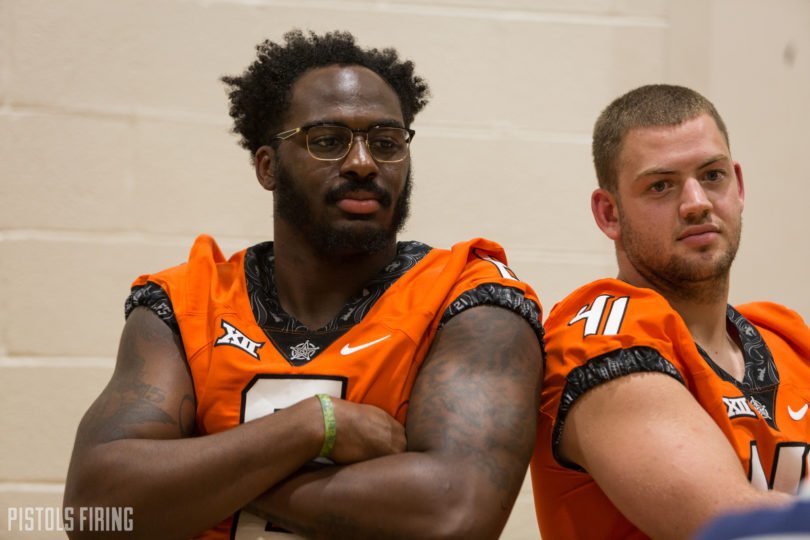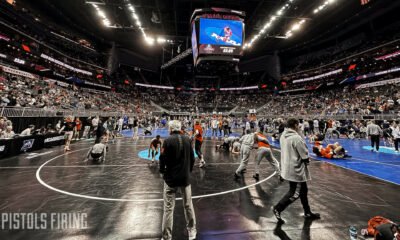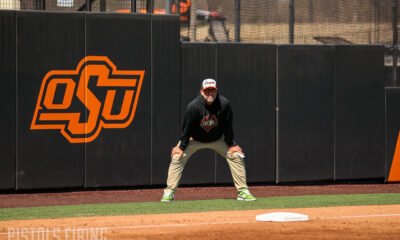Football
The Challenges of Recruiting Cowboy Backs

Coach Mike Gundy signed five tight ends in the 2008 recruiting class. He signed zero the following three years.
“It’s turned a full circle,” Gundy said at Big 12 Media Days. “Years ago, you never saw an offense without one. Then nobody was using one.”
Oklahoma State included.
Over the next few years, Zac Veatch moved from fullback/tight end to offensive lineman and back again, and Keenen Brown went from receiver to cowboy back. It wasn’t until 2015 that cowboy back even became a recruited position.
Coach Jason McEndoo was pulled on board from Montana State, where he ran the offensive line, and was told to get creative.
Over the three-plus years the cowboy back position has been in existence, players as short as 5-foot-10 Luke Hupp or as tall as 6-foot-5 Baron Odom have been raked onto the roster. This outlines a challenge OSU faces in attempting to bring players to be successful at a position that doesn’t exist anywhere in high school football.
As of the 2017 roster, only four of the eight cowboy backs were offered a formal scholarship out of high school, and two of them were in the most recent class.
“It’s really kinda of hard to find ’em and come up with enough to recruit,” Gundy said.
True and false. There are invariably fewer fullbacks and tight ends than almost every other position out there. But when you look at only the states OSU has pulled these types of players from, there are still 24 uncommitted players of at least a two-star rating, according to 247 Sports. That includes recent decommit Nic McTear from Frisco Heritage and his could-be replacement James Palmer out of Westmoore.
That’s not a massive pool, but it’s probably enough. One reason it’s not huge though is because of the allure of the position — or lack thereof.
“There’s not a lot of guys who are fired up about playing fullback or tight end in high school,” Gundy said. “If they have the body structure, they’d rather go over and play defensive end.”
Case and point: Cole Walterscheid. Tight end was Walterscheid’s primary position at Muenster High School, mostly because he only weighed about 210 pounds at 6-5.
That happens a lot and it rarely goes the other way.
“James Castleman, of course he was bigger,” Gundy said. “When we recruited him, he was 245 pounds. He ended up being 300, but he was that type of body structure. We didn’t know he was gonna be 300 pounds.”
It didn’t matter anyway.

Poor No. 9.
Gundy said current defensive end Jarrell Owens is that same body structure. He played running back in high school but hasn’t ran a snap of offense, unless you count the one on defense.
Wild play alert courtesy of @CowboyFB defense.#Big12FB on FS1 https://t.co/9wNohKypWe
— Big 12 Conference (@Big12Conference) October 22, 2016
As for those who will own the position this season, Gundy still believes the cowboy back, on its face, brings an entirely new facet to the offense other positions cannot.
“You have the ability to run a seven-man running play and a five-man passing play with that guy in the game,” Gundy said. “Part of the success with our running game was because of Justice (Hill), but the other part of it was because of our cowboy backs.”

-

 Wrestling3 days ago
Wrestling3 days ago‘We Got a Great Coach’: John Smith Speaks on David Taylor Hire
-

 Wrestling4 days ago
Wrestling4 days agoOSU Wrestling: Thomas Gilman, Jimmy Kennedy Joining David Taylor’s Coaching Staff as Assistants
-

 Wrestling3 days ago
Wrestling3 days ago‘We Want to Get Back to Hanging Banners’: Weiberg on the Decision to Hire David Taylor
-

 Softball4 days ago
Softball4 days agoOSU Softball: Cowgirls Fall to BYU in Big 12 Tournament






